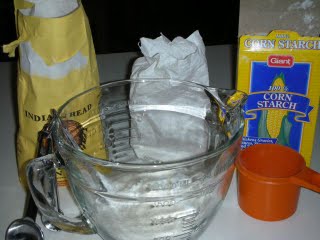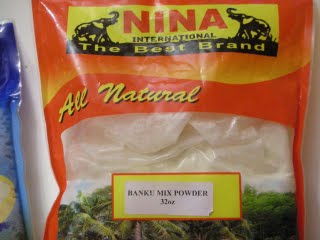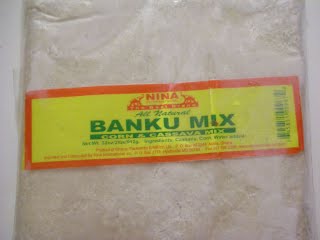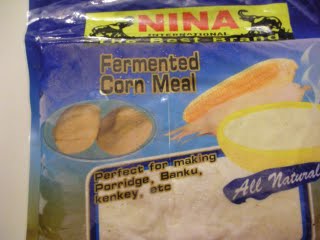Recipe #7: Banku, 4 choices
 Yesterday I mentioned I'd begun fermenting some cornmeal to make the dough for the Ghanaian dish known as banku. The same dough can be used to make a firmer, steamed ball called kenkey (see the March 28, 2007 posting). It takes a few days to get to the right level of sourness, so it'll be a couple more days before I actually make the banku, and perhaps an eggplant or okra stew to serve with it. The way many Ghanaians make banku, and I did for many years, is to put 2 cups of white Indian Head cornmeal (or other similar stone ground cornmeal, but do not use masa harina) into a nonreactive container, like glass or ceramic) with 2 teaspoons of corn starch. Mix them together well (I use a wire whisk), then add 2 cups of lukewarm water. Mix thoroughly, cover lightly and leave to sit in a warm place (counter, stove top or oven) for several days, stirring once a day. The dough should begin to bubble up as it ferments.
Yesterday I mentioned I'd begun fermenting some cornmeal to make the dough for the Ghanaian dish known as banku. The same dough can be used to make a firmer, steamed ball called kenkey (see the March 28, 2007 posting). It takes a few days to get to the right level of sourness, so it'll be a couple more days before I actually make the banku, and perhaps an eggplant or okra stew to serve with it. The way many Ghanaians make banku, and I did for many years, is to put 2 cups of white Indian Head cornmeal (or other similar stone ground cornmeal, but do not use masa harina) into a nonreactive container, like glass or ceramic) with 2 teaspoons of corn starch. Mix them together well (I use a wire whisk), then add 2 cups of lukewarm water. Mix thoroughly, cover lightly and leave to sit in a warm place (counter, stove top or oven) for several days, stirring once a day. The dough should begin to bubble up as it ferments.The Indian Head cornmeal version requires no imported ingredients. If you're unable to find white cornmeal (the preferred one in most of sub-Saharan Africa, for reasons described well in James McCann's excellent 2005 Maize and Grace: Africa's Encounter With a New World Crop, 1500-2000), go ahead and use any stone ground yellow cornmeal/corn flour.
 While we're waiting for the dough to ferment, let me discuss other options for making banku. If you look online or live near a large city that caters to African immigrants, you will likely find several possibilities. The first drawback of the dough described above is that banku is generally made not only from corn, but also cassava (aka, manioc, yucca). Also, the traditional process for producing the corn dough includes first soaking the whole corn overnight, then grinding it. Usually people just take the corn to a local mill that grinds it for them. The result is that the flavor is different (this flavor different has to something to do with the starch/sugar relationship, I was told) and also the corn is ground much more finely than the Indian Head or other stone ground cornmeal available in the U.S. Finally, Ghanaian food scientist Professor Sefa-Dedeh once explained to me that the actual bacteria that grow during the fermentation process are specific to Ghana, and will also produce a different flavor to the dough. He advised me to dry some corn dough in Ghana and use it to make banku in the U.S.
While we're waiting for the dough to ferment, let me discuss other options for making banku. If you look online or live near a large city that caters to African immigrants, you will likely find several possibilities. The first drawback of the dough described above is that banku is generally made not only from corn, but also cassava (aka, manioc, yucca). Also, the traditional process for producing the corn dough includes first soaking the whole corn overnight, then grinding it. Usually people just take the corn to a local mill that grinds it for them. The result is that the flavor is different (this flavor different has to something to do with the starch/sugar relationship, I was told) and also the corn is ground much more finely than the Indian Head or other stone ground cornmeal available in the U.S. Finally, Ghanaian food scientist Professor Sefa-Dedeh once explained to me that the actual bacteria that grow during the fermentation process are specific to Ghana, and will also produce a different flavor to the dough. He advised me to dry some corn dough in Ghana and use it to make banku in the U.S. Fortunately, many shops now import frozen dough or dried powders directly from Ghana. There are several versions. The first is a dried, powdered form to which you just add water. Many people like this, but to me it has an aftertaste. I prefer the frozen dough that includes, as does the
 powdered version, both the cassava and corn doughs. Nina International produces both versions. Finally, there is also the option of having a corn only version of the frozen dough, which has the advantages of being closer to the original banku texture, but without the cassava. It can also be used for other Ghanaian dishes, such as a popular porridge called koko.
powdered version, both the cassava and corn doughs. Nina International produces both versions. Finally, there is also the option of having a corn only version of the frozen dough, which has the advantages of being closer to the original banku texture, but without the cassava. It can also be used for other Ghanaian dishes, such as a popular porridge called koko. 
Labels: banku, cassava, corn meal, Nina International


0 Comments:
Post a Comment
<< Home